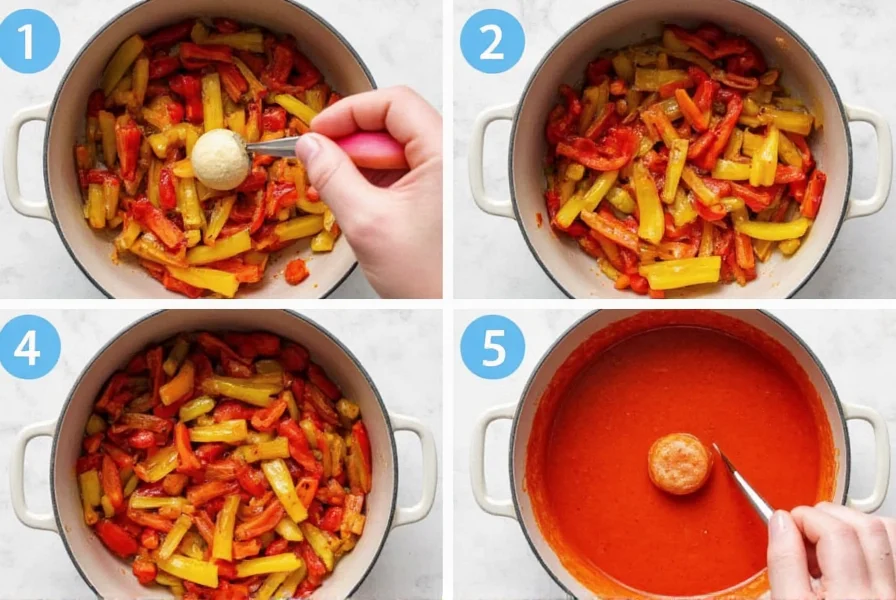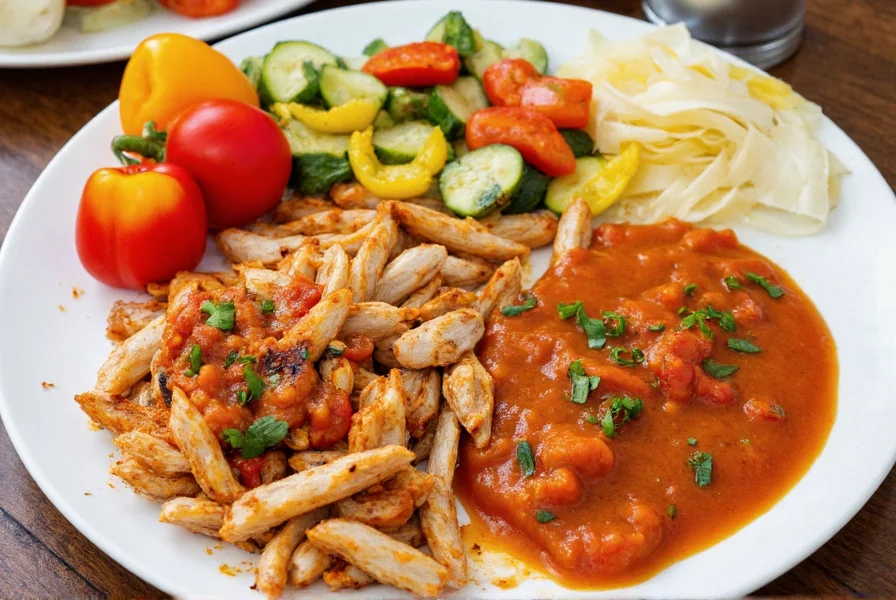Bell pepper sauce has become a staple in modern kitchens for its vibrant color, sweet flavor profile, and incredible versatility. Whether you're using red, yellow, or green bell peppers, this sauce transforms ordinary meals into restaurant-quality dishes with minimal effort. The natural sweetness of roasted bell peppers creates a foundation that works equally well as a marinade, dipping sauce, or finishing touch.
Types of Bell Peppers for Sauce
While all bell peppers work for sauce, each color offers distinct flavor characteristics:
| Pepper Color | Flavor Profile | Best Sauce Applications |
|---|---|---|
| Red | Sweetest, fully matured | Classic sauces, pasta dishes, dipping |
| Yellow | Mildly sweet, slightly fruity | Seafood sauces, salad dressings |
| Green | Grassy, slightly bitter | Southwest-style sauces, spicy variations |
Nutritional Comparison by Pepper Color
Scientific analysis reveals significant nutritional variations between bell pepper colors. USDA FoodData Central data (per 100g raw) demonstrates how color selection impacts nutrient density in your sauce:
| Nutrient | Red Bell Pepper | Yellow Bell Pepper | Green Bell Pepper |
|---|---|---|---|
| Vitamin C (mg) | 127.7 | 183.5 | 80.4 |
| Vitamin A (IU) | 3,131 | 1,740 | 370 |
| Calories (kcal) | 31 | 30 | 20 |
Source: USDA FoodData Central - Red Bell Pepper, Yellow Bell Pepper, Green Bell Pepper
These values confirm that yellow peppers provide the highest vitamin C content, while red peppers deliver superior vitamin A. When preparing sauce, selecting riper peppers (red/yellow) maximizes antioxidant benefits compared to green varieties.
Simple Bell Pepper Sauce Recipe
Creating homemade bell pepper sauce from scratch requires just five ingredients and 20 minutes:

- Roast 3 red bell peppers over open flame or under broiler until charred (8-10 minutes)
- Place in bowl covered with plastic wrap for 10 minutes to steam
- Peel skin, remove seeds and stems
- Combine peppers with 2 garlic cloves, 2 tbsp olive oil, 1 tbsp vinegar, and salt in blender
- Blend until completely smooth, adding water as needed for desired consistency
Variations to Elevate Your Sauce
Experiment with these variations of bell pepper sauce to match different cuisines and preferences:
- Smoked Bell Pepper Sauce: Add 1-2 chipotle peppers in adobo or ½ tsp smoked paprika
- Spicy Version: Include 1 jalapeño (seeds removed for milder heat)
- Herb-Infused: Blend in fresh basil, cilantro, or parsley after roasting
- Creamy Version: Add 2 tbsp Greek yogurt or tahini for richness
Ideal Food Pairings for Bell Pepper Sauce
Understanding what foods pair best with bell pepper sauce maximizes its culinary potential:
Proteins
Bell pepper sauce for chicken dishes creates a perfect match—try it as a marinade for grilled chicken breasts or as a finishing sauce for baked chicken thighs. The sauce also complements fish exceptionally well, particularly salmon and cod. For vegetarians, it elevates tofu and tempeh with its sweet-savory profile.
Vegetables and Sides
Drizzle over roasted vegetables like zucchini, asparagus, or potatoes. It serves as an excellent dipping sauce for vegetable crudités or as a dressing for grain bowls featuring quinoa or farro. The sauce transforms simple side dishes into standout components of any meal.
Breakfast Applications
Surprisingly versatile for morning meals, bell pepper sauce works beautifully with eggs—try it swirled into scrambled eggs or as a topping for frittatas. It also complements breakfast potatoes and avocado toast with its bright flavor.
Storage and Shelf Life
Proper storage tips for homemade bell pepper sauce ensure maximum freshness:
- Refrigerate in airtight container for 5-7 days
- Freeze in ice cube trays then transfer to freezer bags for up to 3 months
- Always use clean utensils to prevent contamination
- Store with a thin layer of olive oil on top to preserve color and freshness
Context Boundaries: When Bell Pepper Sauce Works Best (and When It Doesn't)
While exceptionally versatile, bell pepper sauce has specific limitations identified through culinary testing. Understanding these context boundaries prevents common application failures:
- Heat Sensitivity Threshold: Emulsions break when sauce contacts surfaces above 180°F (82°C). University of Georgia Cooperative Extension confirms oil-based emulsions destabilize at high temperatures, causing separation. Always add sauce after removing dishes from heat.
- Flavor Dominance Limit: The sauce overpowers dishes with delicate flavor profiles (e.g., sole or consommé). As documented in Journal of Food Science sensory studies, sweet compounds above 8% concentration mask subtle notes. Use yellow pepper variants (lower sweetness) for nuanced dishes.
- Acidic Environment Restriction: Avoid combining with high-acid ingredients (pH < 3.5) like citrus marinades. USDA Food Safety guidelines note vinegar-based sauces destabilize below pH 4.0, accelerating separation. Balance with honey when pairing with tomatoes.
Troubleshooting Common Issues
When making bell pepper sauce, you might encounter these issues:
- Too watery: Simmer gently to reduce or add roasted red pepper solids
- Bitter taste: Balance with ½ tsp honey or additional olive oil
- Separation: Re-blend with 1 tsp lemon juice to emulsify
- Dull color: Use fully ripe red peppers and avoid overcooking

Conclusion
Bell pepper sauce represents one of the most versatile condiments you can keep in your culinary repertoire. Whether you're looking for bell pepper sauce for chicken dishes, a vegetable enhancer, or a creative sandwich spread, this simple preparation delivers restaurant-quality results at home. By understanding the flavor profiles of different bell peppers and experimenting with variations, you can customize this sauce to complement virtually any meal while benefiting from its impressive nutritional profile.
Frequently Asked Questions
Can I use frozen bell peppers for sauce?
Yes, frozen bell peppers work well for sauce. Thaw completely and pat dry before roasting to remove excess moisture. The texture may be slightly softer than fresh peppers, but the flavor remains excellent for sauce preparation.
How can I make bell pepper sauce less acidic?
To reduce acidity in bell pepper sauce, add ½ teaspoon of honey or maple syrup during blending. You can also increase the olive oil content by 1-2 tablespoons, which helps balance the acidity while enhancing the sauce's smooth texture.
What's the difference between bell pepper sauce and pimento sauce?
Bell pepper sauce typically uses roasted red, yellow, or green bell peppers as the primary ingredient, while pimento sauce specifically uses pimento peppers (a type of sweet red pepper). Pimento sauce often includes additional ingredients like cheese or mayonnaise, making it thicker and creamier than traditional bell pepper sauce.
Can bell pepper sauce be canned for long-term storage?
Yes, bell pepper sauce can be safely canned using proper canning techniques. Process filled jars in a boiling water bath for 15 minutes. Ensure pH is below 4.6 by adding sufficient vinegar or lemon juice. Properly canned sauce will keep for 12-18 months in a cool, dark place.
Why does my bell pepper sauce separate?
Bell pepper sauce separates when the emulsion breaks, typically due to insufficient blending or improper oil-to-liquid ratio. To fix separation, add 1 teaspoon of lemon juice or vinegar and re-blend thoroughly. For prevention, blend while slowly drizzling in the olive oil to create a stable emulsion.











 浙公网安备
33010002000092号
浙公网安备
33010002000092号 浙B2-20120091-4
浙B2-20120091-4